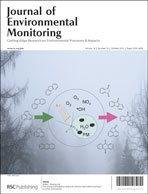Fecal coliform population dynamics associated with the thermophilic stabilization of treated sewage sludge†
Abstract
The inactivation of fecal coliforms in anaerobic batch reactors has been investigated at the thermophilic temperatures of 50, 55 and 60 °C. Throughout inactivation experiments at each temperature, individual colonies were isolated and identified by 16S rDNA gene sequencing to illustrate how the diversity of fecal coliforms is affected by thermophilic treatment. Results indicate that even though fecal coliforms in raw sewage sludge are comprised of several different bacterial species, each with variable temperature induced decay rates, the overall inactivation of fecal coliforms in raw sewage sludge was found to follow a first-order relationship. No tailing was observed across the range of fecal coliform concentrations measured. Fecal coliforms in raw sludge contained six different genera of bacteria and were 62% enriched in E. coli. Within 1.5 log removal of fecal coliform concentration by thermophilic treatment, the populations had shifted to, and remained at 100% E. coli. Subsequent inactivation rates measured in isolated fecal coliform strains confirmed that E. coli cells isolated post-treatment were more thermotolerant than E. coli and non-E coli bacteria isolated prior to thermal treatment. Overall, this study describes the potential enrichment of thermotolerant E. coli in biosolids fecal coliforms and demonstrates that while thermotolerant species are present at the end of treatment, pure first-order approximations are appropriate for estimating residence times to reduce fecal coliforms to levels promulgated in U.S. Class A biosolids standards.


 Please wait while we load your content...
Please wait while we load your content...